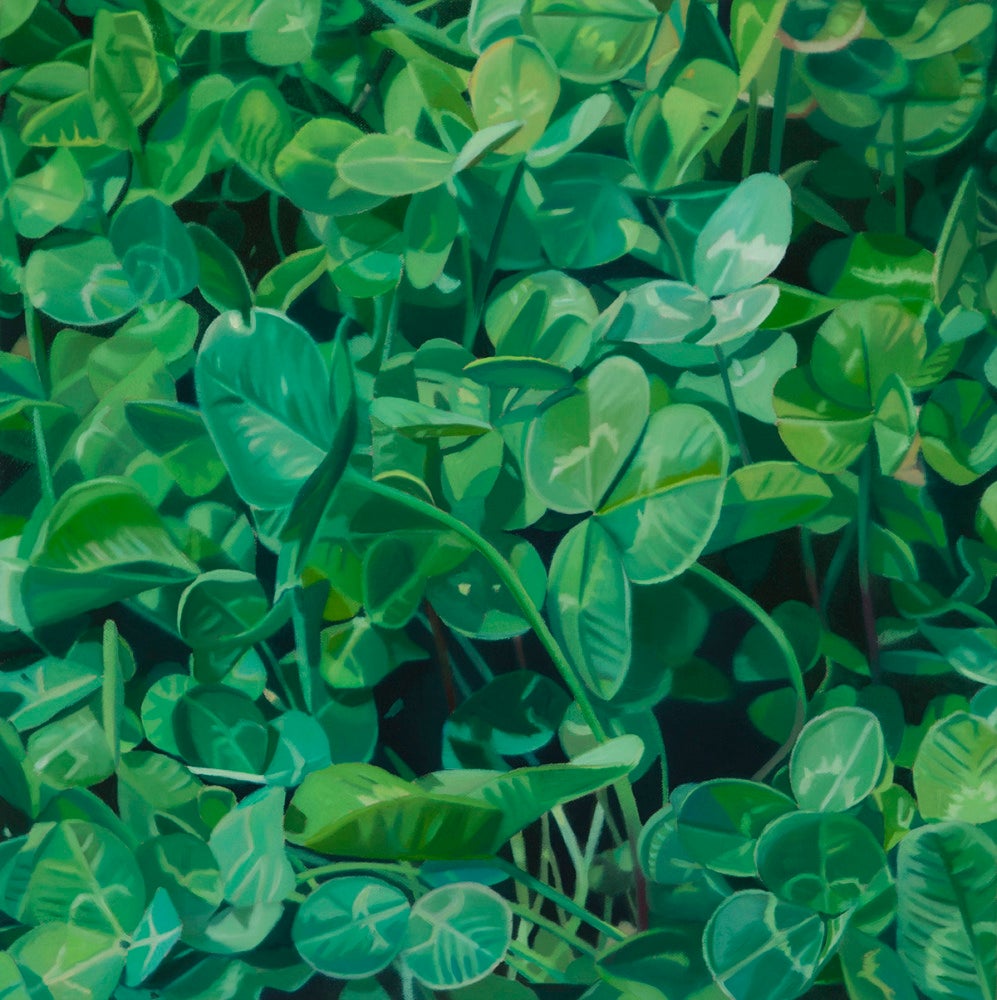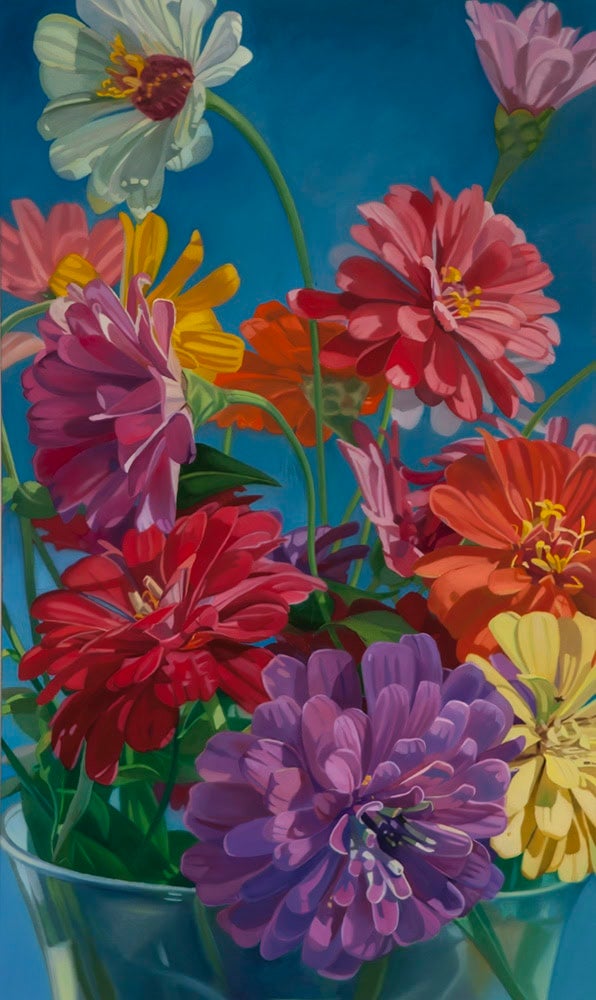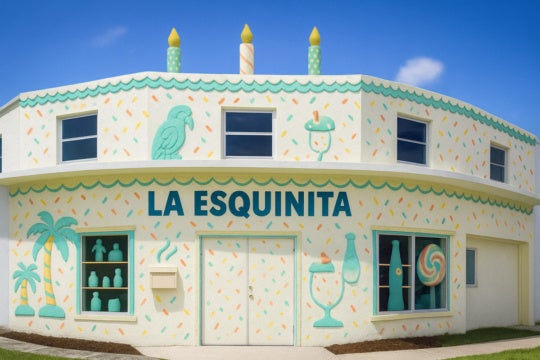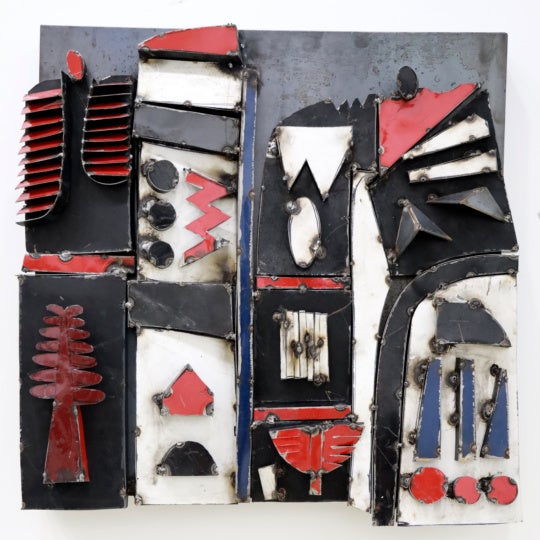
The entryway is light, and the gallery rooms are dim in Beth Edwards’ Wonderstruck, on view at David Lusk Gallery in Memphis. The exhibition is split between two spaces: in the one to the right are Zinnias paintings; and to the left, grassier paintings: Clover, Hydrangea, and Daisies.
Garden III (Joy) in the Zinnias room, has a whale-depth blue background, and the flowers are pink, red, orange, yellow, blue, purple lit with bright daylight. There are three star-shaped periwinkle blue flowers among the zinnias, and there is a daisy with a worm’s nerve on the adjacent wall. All but a few flowers in this large painting make a holistic shift in color and shade. The flowers in the foreground are neatly engineered and singularly hued.
In my mind, I divide these paintings into the categories “Table” and “Garden”. Table paintings have a solid wall of color behind the subject, and garden paintings have plants, out of focus, in the background. There are some small marks of decay in the Table paintings—a frayed petal, missing disk florets, or bug holes, but there is much more rot in the Garden paintings. I see curled petals, many missing disk florets, and some flowers that haven’t come into their fullness yet.
I’m fixated on the drama of Garden III (Joy). The same drama exists in Garden V and Small Hydrangea III. In each of these paintings, there are transparencies and harsh shadows stamped on the flora. It’s a postmark, “from: Sun.” When I see sunlight, I expect the subjects to have scenery or atmosphere blooming behind them, but these paintings only have flatly colored backgrounds. How can there be sun without earth? I call this type of interrupted expectation, drama. The disjointed background and foreground lighting —in Garden III (Joy) especially— reminds me of Claire Denis’ High Life (2018). The film follows a spacecraft containing people and a greenhouse as it travels into a black hole. In the opening sequence, the camera moves over misted plants, with colored light suspended in the mist. In Edwards painting, the plants are sustained by light in an otherwise lightless environment, as Denis’ people and plants are sustained in space, and this makes their thriving mysterious and unsettling. These flowers, those astronauts, inhabit capsules of fragile safety as they float in impossibility.

I am at the Nordstrom’s counter. I’m nine, and my glamorous mother is sampling perfumes, unctuous puffs on strong white cardstock. The cards are laid perfectly parallel on the counter. I can see that Edwards’ Zinnia paintings are finely considered and differentiated, and the moods could be described with scent profiles: musky, light, grassy, dark, sweet. Like luxurious perfumes, I feel these paintings are for choosing among, and that they are not for me. I ask art to break my heart, and these paintings do not. I think they would look glorious in a home and bring outdoors brightness without pollen. These paintings make flowers delicious, but I want to be moved by the strangeness I see in Edwards’ At Peace, 2009. At Peace depicts a duckling wearing a clover hat in a room’s corner. The wall behind the duckling holds a window with branches in the background, and the wall the duckling is facing holds a painting full of downcast people. The duckling lifts a wing and smiles at the painting, eyes closed. At Peace is menacing and delightful in a way I miss in the Zinnia works.
Clover XIX is unique among the Clover, Hydrangea, and Daisies grouping of the second room. I imagine the gallery space as a pie of whipped grass because I am refreshed by the tangled bodies of the hydrangeas and the activity of the clovers. This room of paintings becomes a pail of fresh cow milk with some grass in it, and Clover XIX is that milk whipped and dolloped on the ground with the sun shining on it! The little bits of grass are all chopped up, and the sun is so fluffy. If I was a little overwhelmed by the multicolored zinnias, such that the room got stuffy, here, I feel lifted by the green color scheme. In Clover XX,the stems are thin and lean in tenderly to watch their leaves fight in a free-for-all. The center of the picture is all leaves, both sharp and soft and in their tussle, everybody is somebody’s hot knife, and everybody’s somebody’s butter. This room smells more alive and greener—I want to toddle, bend, and burrow. I was a child the last time I bent so close to clover, and this breaks my heart.
Beth Edwards: Wonderstruck is on view at David Lusk Gallery in Memphis through May 1, 2021.




